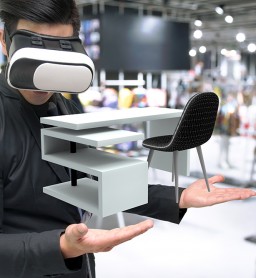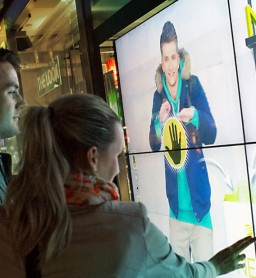Before getting into the details, let’s start with a few examples to show which doors the metaverse has the potential to open up in the future:

Megatrend Metaverse
NFTs, avatars, holograms, virtual reality and blockchain: all part of the metaverse – a network that brings together elements of the real and virtual worlds. But what’s behind it all? What exactly is this new world all about?
Thema:
digital
Digitalisierung
metaverse
Trend
virtual world
virtuelle Erlebnisse
- Suddenly, getting together with friends who are a long way away is actually possible again. Maybe they are living in America or Australia right now. But that doesn’t matter any more: just arrange to meet up in the metaverse, go for a walk together as avatars and enjoy a great time strolling side by side.
- Imagine for a moment that you couldn’t get hold of tickets for your favourite band, but you’re still able to be there all the same. Front row and centre, live and in 3D – and not just on a screen.
- In the digital realm of The Sandbox, you can trade plots of land; depending on their size, they can go for anywhere up to several hundred thousand euros. To pick one example entirely at random, one plot next to Snoop Dogg proved particularly popular.
So what distinguishes the metaverse from cyberspace as we know it today?
It all started with Web 1.0, back in the days when a PC screen was our sole interface. A time when we were limited to things like surfing websites and looking up people’s contact details. And then it all continued with Web 2.0, when social media and a switch to mobile handsets spurred developments. Facebook, Amazon and Google had arrived. No longer tied to our PCs, smartphones start to take over, allowing us to shop, get in touch with friends or look up recipes wherever we went. And now, the metaverse is ushering in the era of Web 3.0: it will see us become part of the internet, embedded WITHIN it.
Perhaps the best way to frame the metaverse is as the sum of various interconnected virtual worlds – of which there are already a great many. It can be seen as an extension of our human habitat, because – unlike video games, where you take on the role of a character – in the metaverse you star as yourself through the medium of a very personal avatar, which can interact, shop, play and even work. Put simply, digitalised reality has arrived!
Features of the metaverse at a glance
- In many ways, it feels like the metaverse is opening up a gateway leading directly into the future. The technological developments underlying the new virtual worlds are delivering a completely new perspective on what digitalisation is capable of. Advances in AR and VR are a key step for the metaverse. These new technologies make it possible to move around the virtual space freely, and experience it with all the senses, rather than being limited to a screen and headset. It’s only a short leap from virtual reality to a metaverse where everything seems possible.
- The metaverse is a decentralised construct. Anyone can create new worlds and spaces, everyone can decide for themselves with their avatar which world, which space, which environment, which social interaction they go into – as well as which other people or avatars they meet.
- One feature of the metaverse is that it can never be ended or paused. It simply goes on and on.
- The metaverse is live. While it is true that events happen within a specific timeframe in the metaverse, just like they do in the real world, the metaverse itself plays out in real time.
- And there’s no limit on participant numbers.
- The metaverse has its own economy. Companies and individuals can make investments, buy, sell and get paid for work within the metaverse. Here, cryptocurrencies serve as money.
Right now, digital worlds of all sizes are springing up everywhere. The best known are currently Decentraland, The Sandbox, Roblox, Fortnite, Axie Infinity, Metahero, Bloktopia, My Neighbor Alice, Star Atlas and Upland.
Mark Zuckerberg and the metaverse
Contrary to the widespread misconception, the metaverse was not in fact invented by Mark Zuckerberg’s company Meta. The term has actually been around since 1991 when Neal Stephenson coined it in his science fiction novel Snow Crash. That said, Mark Zuckerberg is undeniably one of the metaverse’s greatest champions, having already poured several billion dollars into its expansion. His goal is to bring the virtual space to life as a meeting place, workplace, recreational space and much more besides. If Zuckerberg has his way, we will no longer surf Facebook and the like with our mobile phones or computers in the future. Instead, we will use virtual reality goggles – just like the ones offered by MaxFive – to immerse ourselves in the virtual worlds of the metaverse. We at MAXFIVE use this technology for e.g. virtual employee training for branch operations.
Retail as the great hope for the metaverse
One major source of hope for the future of the metaverse is the retail sector, which could use the new space to open up fresh e-commerce channels. Big-name retail chains are already starting to dip a toe in the metaverse, where they are starting to road test various new distribution channels.
- Rivals Nike and Adidas are leading the way with their strategies. Last autumn, Nike launched its 3D Nikeland, which is modelled on the real-world Nike headquarters. Here, fans of sport and fashion are brought together in the digital realm. Digital sporting events take place and Nike products are available for sale virtually. Adidas, meanwhile, is cooperating with The Sandbox, where it is looking to create its own Adiverse experiential universe.
- In the USA, retail giant Walmart is working on its own virtual shopping experience. A video on YouTube reveals how customers could soon go into the store pushing their digital shopping trolley, enter a shopping list and let a ghost shop assistant guide them through the aisles. Once done, they pay using Walmart Pay and the goods are delivered to their real-world address.
- Kaufland opened an island called Kaufisland in the Animal Crossing game world in January, where the company is providing information about its sustainability strategy. Users can find out more about the origin of the food they buy and what happens to returned bottles.
-
- H&M can also be found on Animal Crossing, this time on the island of Looop, which showcases the fashion chain’s clothing recycling system of the same name. H&M also tested special body scanners in three of its branches in Hamburg and Berlin last autumn, so that customers could create avatars matching their exact measurements. They were then able to dress their new digital doppelgänger in fashion from H&M’s No Fear To Try collection before rotating them through 360 degrees to inspect the outfits from every angle.
- Fashion brands are increasingly tapping into the metaverse’s potential as a virtual showroom. In March 2022, the first „Metaverse Fashion Week took place in Decentraland. It racked up around 70 shows featuring brands such as Tommy Hilfiger and Etro. More than 100,000 participants browsed digital stores, attended virtual parties and took part in NFT drops.
- Now that competitor Zalando has completed its takeover of Swiss body scan start-up Fision, it is gearing up to release an app that allows users to measure their own body precisely and create their very own avatar, which then tries clothes out for size digitally. Ultimately, the goal is to cut the return rate for garments bought online.
What’s next for the metaverse?
There’s definitely still a number of problems that need to be solved before people keep on coming back to the metaverse. The first, and probably biggest issue is a hardware one. At present, virtual reality headsets are still pretty clunky. And they only work for a few hours before they need recharging. Also, the graphics are not realistic enough to properly engage users.
But in spite of everything, industry experts are firmly convinced that the metaverse is here to stay, especially as big tech companies like Meta, Microsoft and Sony are already betting big on it. Even so, the metaverse will only achieve widespread acceptance if all the major internet companies pull together in one direction. And two important names are conspicuous by their absence: Apple and Google. Both are working on their own augmented reality headsets. Rather than displaying completely virtual worlds, their versions enrich the real world with various virtual heads-up elements such as navigation graphics (aka mixed reality).
Categories

With all senses: MAXFIVE turns 30
Cheers to that!
MAXFIVE

Can you speak the language of digitalisation?
We are surrounded by digital products and services 24 hours a day. So now it’s time, once and for all, to explain what they can do. And where they come from.
MAXFIVE

Let there be light!
How light influences (consumer) behaviour
MAXFIVE
